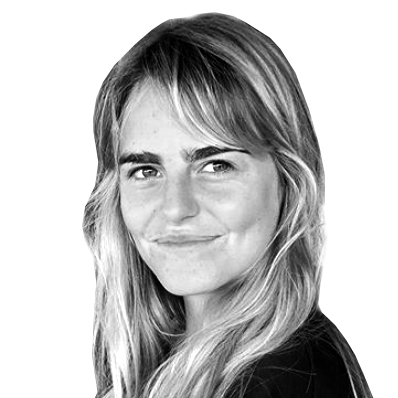The San Luis Valley stretches 125 miles long and more than 65 miles wide, from Colorado down into New Mexico. “It’s a mythical place,” says the 37-year-old artist Marguerite Humeau. In the world’s largest alpine valley, she’s created Orisons, a 160-acre plain populated by hammocks and abstract, wind-activated sculptures. “The closest cultural institution to [Orisons] is a U.F.O. watchtower.”
Up since last July, Orisons is one of the largest pieces of land art ever made by a woman, and Humeau’s most ambitious project to date. Over three years—and with help from a team of 52 experts, including conservationists, ornithologists, and geomancers—she installed 84 sculptures in the valley. With gusts of wind, the small sculptures whistle in unison. The larger sculptures are meant to look like sandhill cranes.

Humeau’s eco-system attempts to re-summon the energy of the once fertile land and honor its history. “I’m interested in the transformative power of sculpture,” Humeau says. “I’m not interested in dead objects.”
Growing up in Beaupréau, a small town in the French countryside, Humeau was immersed in the arts. Her mother is a painter, and her father an architect. As a little girl, she played in nature every day. “We were in tune with the changing seasons,” she says. “We would go foraging for chestnuts, and watch the swallows coming in at the beginning of spring.” While her family was Catholic, she strayed from the Church. “I started looking for my own mythologies.”
After high school, Humeau moved to Paris to study textiles at ENSAAMA (École Nationale Supérieure des Arts Appliqués et des Métiers d’Art), then to Eindhoven, in the Netherlands, to study design. But at age 21, Humeau had “an intense health accident.” Though she avoids discussing details of the health scare, she says coming face-to-face with death changed her life. “I realized how little time we have, and that I wanted to create.”
“I’m interested in the transformative power of sculpture.”
In 2011, she enrolled in a graduate program in design interactions at London’s Royal College of Art. The program was more experimental than a traditional fine-arts degree and encouraged collaboration across disciplines. Her class was instructed to study technological developments and speculate on the future.

In her research, Humeau found a video of an engineer who used a 3D printer to make organs, which sparked an idea: she could engineer the vocal tracts of a dead creature in an attempt to hear its voice. Humeau re-created the voice box of Lucy, a 3.2-million-year-old ancestor of humans, by analyzing her skull and CT scans of chimpanzees. With sculptural windpipes and an artificial breathing machine, she created a work that made sounds Lucy likely did.
After displaying Lucy in her graduation exhibition, Humeau got a call from Paola Antonelli, then the head of MoMA’s Architecture and Design Department. Antonelli put the piece in a show, then, eventually, MoMA purchased it.

The MoMA acquisition kicked off her career. Three years later, Humeau had her first solo show at Import Projects, a gallery in Berlin. For it, she expanded the concept behind her thesis by studying the fossilized bones that surrounded the vocal cords of three extinct creatures—a terminator pig, a “walking whale,” and a mammoth—to create sculptures that sounded like the dead animals.
In 2015, when she returned to Berlin to exhibit another project, she stayed with the Swiss artist Julian Charrière, who was also hosting the then curator for the Palais de Tokyo, in Paris. “We clicked,” says Humeau. The curator invited her to mount a solo show at the museum. “It was a dream come true. I couldn’t believe it.” Within a few years, exhibitions at Tate Britain, the Centre Pompidou, and Versailles followed.
During the coronavirus pandemic, when galleries and museums around the world shuttered, Humeau had some downtime to plot a massive project. While researching plants, she found an article about circuit irrigation systems, which mitigate the impact of recurring droughts in the Colorado River Basin.
Humeau teamed up with Black Cube Nomadic Art Museum, an experimental nonprofit based in Denver, to work on a project in the San Luis Valley. They put her in touch with the Jones family, who owned Colorado land that once had an irrigation system. They’re “a family of farmers that are really radical, who are thinking about organic farming and regenerative farming in ways that are avant-garde and experimental,” says Humeau.

Initially, Humeau envisioned a work similar to Robert Smithson’s Spiral Jetty, but as she studied the land, she realized transforming it wasn’t the point. Instead, she would work with it. Many sculptures mimic the four types of microscopic plants she found in the area.
Although Humeau is pleased with her work, she doesn’t think she should be the focus of the installation. “The land is the work. My sculptures, they’re tiny because I want them to have the power to regenerate what’s around them,” she explains. “It’s their inner power that’s going to have an impact.”
Orisons is on view in the San Luis Valley, in Colorado, through June 30, 2025
Check out AIR MAIL’s Arts Intel Report, our newly revamped research tool for what to do, see, and watch around the world
Elena Clavarino is a Senior Editor at AIR MAIL

